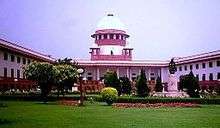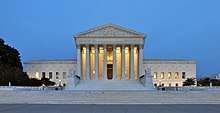Unconstitutional constitutional amendment
An unconstitutional constitutional amendment is a concept in judicial review based on the idea that even a properly passed and properly ratified constitutional amendment, specifically one that is not explicitly prohibited by a constitution's text, can nevertheless be unconstitutional on substantive (as opposed to procedural) grounds—such as due to this amendment conflicting with some constitutional or even extra-constitutional norm, value, and/or principle.[1][2][3] As Israeli legal academic Yaniv Roznai's 2017 book Unconstitutional Constitutional Amendments: The Limits of Amendment Powers demonstrates, the unconstitutional constitutional amendment doctrine has been adopted by various courts and legal scholars in various countries throughout history.[1] While this doctrine has generally applied specifically to constitutional amendments, there have been moves and proposals to also apply this doctrine to original parts of a constitution.
Concept




The idea of an unconstitutional constitutional amendment has been around for over a century—with it being embraced by former Michigan Supreme Court Chief Justice Thomas M. Cooley in 1893[4] and US law professor Arthur Machen in 1910 (in Machen's case, in arguing that the Fifteenth Amendment to the United States Constitution might be unconstitutional).[5] This theory is based on the idea that there is a difference between amending a particular constitution (in other words, the constitution-amending power) and revising it to such an extent that it is essentially a new constitution (in other words, the constitution-making power)—with proponents of this idea viewing the former as being acceptable while viewing the latter as being unacceptable unless the people actually adopt a new constitution using their constitution-making power.[6] Thomas M. Cooley insisted that amendments "cannot be revolutionary; they must be harmonious with the body of the instrument".[7] Elaborating on this point, Cooley argued that "an amendment converting a democratic republican government into an aristocracy or a monarchy would not be an amendment, but rather a revolution" that would require the creation and adoption of a new constitution.[7]
In a 1991 law review article of his, United States law professor Richard George Wright argues that if a constitutional amendment leaves a constitution in such a state that it is a "smoldering, meaningless wreckage" and extremely internally inconsistent and incoherent, then such an amendment should indeed be declared unconstitutional.[6] Wright compares this to a scenario of a body rejecting a tissue transplant due to this transplant being extremely incompatible with the body to which it is grafted—thus triggering an immune response on the part of the body.[6] In Wright's analogy, the constitution is the body and the amendment is a tissue transplant and while both can peacefully coexist separately, they cannot peacefully coexist together.[6] While Wright rejects the idea that certain specific hypothetical amendments are unconstitutional (such as an amendment that abolishes one or more US states), Wright does agree with Yale law professor Akhil Amar's view that a hypothetical constitutional amendment that completely abolishes freedom of speech would be unconstitutional due to the fact that such an amendment would also undermine many other US constitutional provisions and thus "leave standing only a disjointed, unworkably insufficient, fragmentary constitutional structure."[6] Such an amendment would not only conflict with the provisions of the US Constitution's First Amendment—such an override being in fact not unheard of—but also with an innumerable multitude of other US constitutional provisions.[6] Wright also agrees with US law professor Walter F. Murphy's view that a constitutional amendment that legally enshrines white supremacy, limits the franchise to whites, requires both US state governments and the US federal governments to segregate public institutions, and authorizes other legal disabilities that clearly offend and even deny the human dignity of non-whites would be unconstitutional due to the fact that this amendment "conflicts fundamentally and irreconcilably with virtually all conceptions of the commonly cited constitutional value of equality."[6]
National views about this theory
Countries that have adopted this theory
India
In the 1960s and 1970s, the Indian Supreme Court articulated the basic structure doctrine—as in, the idea that a constitutional amendment that violates the basic structure of the Indian Constitution should be declared unconstitutional.[8] This was a significant reversal from 1951—when the Indian Supreme Court declared that the constitutional amendment power was unlimited.[9]
Honduras
In 2015, the Honduran Supreme Court declared unconstitutional a part of the original 1982 Honduran Constitution that created a one-term limit for Honduran Presidents and also created protective provisions punishing attempts to alter this presidential term limit.[10] This case was novel in the sense that a part of an original constitution rather than a constitutional amendment was declared unconstitutional.[10]
Countries that have rejected this theory
Finland
The Finnish Parliament enjoys parliamentary sovereignty: its acts do not undergo judicial review, and cannot be stricken down by any court, so the constitutionality of a constitutional amendment is a purely political question. A 5⁄6 supermajority can immediately enact an emergency constitutional amendment. In 1973, President Urho Kekkonen requested a four-year term extension by means of an emergency constitutional amendment, in order to avoid arranging presidential elections. He succeeded in persuading the opposition National Coalition Party and Swedish People's Party to vote for the amendment, and got his extension. In response, dissidents formed the new Constitutional Right Party, which campaigned in the 1975 Finnish parliamentary election with the theme that Kekkonen's amendment was an "unconstitutional constitutional amendment." However, they won only one seat, not being able to change the outcome.
Potential future applications
In a 2016 op-ed, published just a month after the 2016 US presidential election, US law professor Erwin Chemerinsky argued that the United States Supreme Court should declare the unequal allocation of electoral college votes to be unconstitutional due to it being (in his opinion) contrary to the equal protection principles that the US Supreme Court has found in the Fifth Amendment.[11] Chemerinsky argues that a part of the United States Constitution can be unconstitutional if it conflicts with some principle(s) in a subsequent US constitutional amendment (as this amendment is interpreted by the courts, of course).[11] At around the same time that Chemerinsky published his op-ed, in an article in the Huffington Post, US law professor Leon Friedman made an argument similar to Chemerinsky's.[12] (To avoid any confusion here, what Chemerinsky and Friedman are advocating in these articles of theirs is having the US Supreme Court reinterpret existing amendments to the US Constitution as opposed to having the US Supreme Court add new amendments to the US Constitution; the US Supreme Court is allowed to do the former but not the latter.[11][12])
In a 2018 blog post, US law professor Michael Dorf points out that it is possible (as opposed to plausible) for the United States Supreme Court (SCOTUS) to utilize the unconstitutional constitutional amendment doctrine to strike down the unequal apportionment in the United States Senate (which violates the one person, one vote principle); in the very same article, however, Dorf also expresses extreme skepticism that the US Supreme Court (or even a single justice on the US Supreme Court) would actually embrace the unconstitutional constitutional amendment doctrine—at least anytime soon.[3]
Criticism and responses to criticism
US law professor Mike Rappaport criticizes the unconstitutional constitutional amendment doctrine and argues that the adoption of this doctrine in the US would undermine popular sovereignty due to the fact that nine unelected US Supreme Court Justices with life tenure would give themselves the power to overturn the will of a huge majority of the American people.[2] Rappaport points out that having the US Supreme Court adopt this doctrine might not always result in outcomes that liberal living constitutionalists are actually going to like (for instance, Rappaport mentions about how the US Supreme Court could use this doctrine to strike down a new constitutional amendment that will overturn the 2010 Citizens United ruling due to a belief that this new amendment conflicts with the First Amendment and the idea of free speech that the First Amendment embodies) and also argues that such a move on the part of the US Supreme Court would obstruct the US constitutional amendment process even further because people are going to hesitate putting a lot of effort into passing a new constitutional amendment if they will think that the US Supreme Court might or will strike down this amendment and declare it unconstitutional.[2] Rappaport is also critical of the tendency in the US to use the judiciary to achieve various constitutional changes outside of the Article V constitutional amendment process due to the fact that this reduces the incentive to actually pass and ratify new US constitutional amendments since achieving constitutional change through the courts is so much easier than going through the extremely long and cumbersome Article V constitutional amendment process (since convincing five or more Justices on the US Supreme Court to agree with one's position is astronomically easier than getting two-thirds of the US Congress and three-fourths of US state legislatures to agree with one's position).[2]
Meanwhile, in response to criticism that the unconstitutional constitutional amendment theory blocks (constitutional) change, US law professor David Landau pointed out that this theory has ways to get around it.[13] Specifically, Landau argues that political actors can engage in wholesale constitutional replacement in response to a judicial ruling that declares a particular constitutional amendment to be unconstitutional and also argues that political actors can "exert influence over the court[s] through appointments and other devices[]" in order to have the courts deliver rulings in these political actors' favor.[13] Thus, Professor Landau--along with Australian law professor Rosalind Dixon--argues that a "speed bump" is the more proper comparison for the unconstitutional constitutional amendment doctrine and that while the unconstitutional constitutional amendment doctrine can delay change--perhaps with the hope of allowing a new political configuration to emerge in the meantime--it cannot permanently prevent (constitutional) change due to the fact that political actors have workarounds (that are mentioned earlier in this paragraph) to achieve (constitutional) change even in the face of a(n initially) hostile judiciary.[13]
References
- Roznai, Yaniv (September 19, 2017). Unconstitutional Constitutional Amendments: The Limits of Amendment Powers. Oxford University Press. ISBN 9780198768791 – via Google Books.
- Rappaport, Mike (June 28, 2018). "The Problems With Declaring Procedurally Valid Constitutional Amendments to be Unconstitutional". The Originalism Blog. Retrieved September 21, 2019.
- Dorf, Michael C. (November 12, 2018). "How Much of a Problem is the Senate?". Take Care. Retrieved September 21, 2019.
- Yaniv Roznai (1971-09-13). "Towards A Theory of Constitutional Unamendability: On the Nature and Scope of the Constitutional Amendment Powers". Juspoliticum.com. Retrieved 2019-10-11.
- Machen, Arthur W. (1910). "Is the Fifteenth Amendment Void?". Harvard Law Review. 23 (3): 169–193. doi:10.2307/1324228. JSTOR 1324228.
- "Could a Constitutional Amendment be Unconstitutional?" (PDF). Semantic Scholar. Loyola University Chicago Law Journal. 1991. Retrieved 2019-09-19.
- http://etheses.lse.ac.uk/915/1/Roznai_Unconstitutional-constitutional-amendments.pdf
- https://digitalcommons.wcl.american.edu/cgi/viewcontent.cgi?article=1404&context=auilr
- https://digitalcommons.law.yale.edu/cgi/viewcontent.cgi?article=1685&context=yjil
- Roznai, Yaniv; Dixon, Rosalind; Landau, David (2018-07-04). "From an Unconstitutional Constitutional Amendment to an Unconstitutional Constitution? Lessons From Honduras by David Landau, Rosalind Dixon, Yaniv Roznai :: SSRN". FSU College of Law, Public Law. SSRN 3208185.
- Erwin Chemerinsky. "Why the Electoral College system violates the Constitution: Erwin Chemerinsky – Daily News". Dailynews.com. Retrieved 2019-10-08.
- Leon Friedman. "Is The Electoral College System For Choosing Our President Unconstitutional?". HuffPost. Retrieved 2019-10-08.
- "Yale Journal of International Law | Archives | 2018 | February". Yjil.yale.edu. Retrieved 2020-04-02.